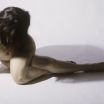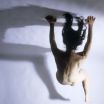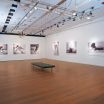Soft Targets
Soft Targets
Year: 2004
Medium: archival digital prints
Exhibited:
Roslyn Oxley Gallery, Sydney
Body Double, MCA, Sydney
NGV, Melbourne
Arc One Gallery, Melbourne
Press Release:
Julie Rrap’s current exhibition at Roslyn Oxley9 Gallery consists of thirteen large format digitally manipulated photographs printed on traditional watercolour paper. Female nudes are digitally contorted but the natural callisthenic agility and muscularity of the life model makes it difficult for the viewer to identify what’s real and what’s not. Rrap has long been interested in the position occupied by the human figure, and the female nude in particular, in the history of European art and popular culture. It is a theme she has approached from many directions, always using her own body as subject. She is her own victim. In Soft Targets, Rrap looks in particular at the malleable potential of the human form at the moment of representation. Shadows feature prominently in the work, creating ghost-like other presences that seemingly have a life of their own. They refer metaphorically to the hierarchy of mimesis, to the relationship between original and copy. Somehow Rrap’s shadows appear to be more alive than the more fleshy and more mortal figures from which they were born.
The human body is a vulnerable thing and Rrap incorporates into the present work the sinister implications of this fact. In Soft Targets, the human figure is at once elevated to an aesthetic ideal and damned as a target of willful damage and destruction or calculated military aggression. Each photograph is titled after a specific military term which reveals the high level of precision engineering employed to raise the killing efficiency of weaponry along with the tendency of things in the real world to deviate from such ideals. The artist has provided a glossary of terms: Boat Tail – Bullet of tapered base or truncated conical base design, which raises the ballistic coefficient factor by reducing the aerodynamic drag, providing greater stability at subsonic velocities; Drag – The aerodynamic resistance to a bullet’s flight; Fish-tailing – The result of the bullet base collapsing in the target, causing the bullet to bend and deviate from course; Flyer – A shot considerably outside a normal group on a target, not representative of the rifle’s or load’s potential accuracy; Hangfire – Extended delay (up to a second or more) between the firing pin blow and the ignition of the powder, usually caused by old or contaminated primer/propellant which ignites slower than usual.
Interestingly, these terms also reveal that the process of looking is central to the act of killing. For, just as one looks at a work of art, or peers through a camera lens, one fixes a target in ones sights: Cheekpiece – A raised part of the side of the stock of a shoulder-arm against which the shooter rests his face. Its purpose is to raise the shooter’s eye to the height necessary to maintain the triangle of force; Hooded Sight – A front sight that is equipped with a metal canopy. Designed to eliminate light reflections, as well as to protect the sight pillar; Ghost Ring – Rear sight in the form of an aperture mounted close to the shooter’s eye. Shooter “peeps” through the aperture, centering the front sight in the circle of the rear sight picture. The longer sight radius facilitates higher practical accuracy potential, and the system reduces the number of objects on which the eye must focus from three (rear sight, front sight and target) to two; Windage – The adjustment on the telescope or iron sights to compensate for horizontal deflection of the bullet. The distance or amount of horizontal correction that a sniper must use to hit his target due to the effects of wind or drift).















